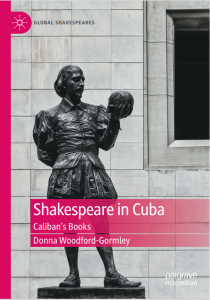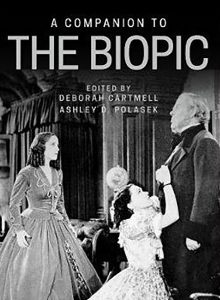About This Clip
The Tempest
The Tempest
News
Shakespeare in Cuba: Caliban’s Books
Donna Woodford-Gormley's new book, Shakespeare in Cuba (2021), uses the lens of cultural anthropophagy to explore Cuban adaptations of Shakespeare. According to the theory of cultural anthropophagy, or literary cannibalism, a culture, like Cuba, can consume Shakespearean plays, but digest them and embody them in new ways, giving life to both the consumed and the consumer. The theory has its roots in Latin America, and so it is an appropriate tool for examining how Shakespeare’s plays have been consumed, digested, and embodied in Cuban forms, but it is also an inclusive theory that places neither culture in a position of subservience and allows all to join the feast.more
Donna Woodford-Gormley‘s new book, Shakespeare in Cuba (2021) in the Global Shakespeares series edited by Alexa Alice Joubin, uses the lens of cultural anthropophagy to explore Cuban adaptations of Shakespeare. According to the theory of cultural anthropophagy, or literary cannibalism, a culture, like Cuba, can consume Shakespearean plays, but digest them and embody them in new ways, giving life to both the consumed and the consumer. The theory has its roots in Latin America, and so it is an appropriate tool for examining how Shakespeare’s plays have been consumed, digested, and embodied in Cuban forms, but it is also an inclusive theory that places neither culture in a position of subservience and allows all to join the feast.
The subtitle of the book: “Caliban’s Books,” alludes to Caliban’s instructions to Stefano and Trinculo to steal Prospero’s books. Cuban artists, this book suggests, have taken Caliban’s suggestion and possessed Shakespeare’s books, consuming them, digesting them, and making them their own.
 While the theory of cultural anthropophagy is applied to all the Cuban adaptations discussed in Shakespeare in Cuba, these adaptations embody Shakespeare in many different ways. Some works engage with and enter into a discussion about the colonial history of Cuba and Latin America. For example, one of the best known Cuban adaptations of Shakespeare is Roberto Fernández Retamar’s landmark essay, “Caliban.” In this essay Fernández Retamar takes on the voice of Caliban and uses it to speak back to Prospero and to colonizers.
While the theory of cultural anthropophagy is applied to all the Cuban adaptations discussed in Shakespeare in Cuba, these adaptations embody Shakespeare in many different ways. Some works engage with and enter into a discussion about the colonial history of Cuba and Latin America. For example, one of the best known Cuban adaptations of Shakespeare is Roberto Fernández Retamar’s landmark essay, “Caliban.” In this essay Fernández Retamar takes on the voice of Caliban and uses it to speak back to Prospero and to colonizers.
A later Cuban adaptation of the play, however, takes a different approach. Teatro Buendía’s Otra tempestad [Another tempest] combines characters from The Tempest with characters from other Shakespearean plays and with elements of Cuban culture. The Shakespearean characters find themselves shipwrecked on the island of Cuba, where they encounter afro-Cuban orishas, the deities brought to Cuba by the slaves. In Otra tempestad these deities are the daughters of Sycorax, but the Shakespearean characters continually mistake them for people they left behind in the old world. Flora Lauten and Raquel Carrió, the director and dramaturge of this play, explained that they were trying to move beyond either faithfully imitating Shakespeare’s play or speaking back to the colonizer. They wanted to create a third language that would allow for a dialogue between the Shakespearean original and the Cuban response. The Caliban of their play represents that third language. A video of Otra tempestad is available at NYU’s Hemispheric Institute.
Unsurprisingly, given that Cuba’s 1959 revolution has been one of the most notable events in the country’s recent history, other Cuban adaptations of Shakespeare are overtly political. Romeo y Julieta en Luyanó, for example, was written and performed by members of a CDR or Committee in Defense of the Revolution. CDRs are neighborhood groups, established by Fidel Castro in 1960. They are charged with attending to the needs of a community, including promoting public health campaigns and encouraging education and involvement in the arts. However, they are also responsible for policing the revolutionary or counterrevolutionary behavior of the community members. This play shows the CDR accomplishing all of these tasks. The amateur actors and writers involved in creating the play repeatedly assert the revolutionary ideals of the characters and participants, while also demonstrating the importance of community artistic involvement in Cuba.
In addition to incorporating references to Cuban politics, the play also combines allusions to Romeo and Juliet with revolutionary Cuban traditions of using theatre to involve community members in the resolution of their own problems. Several Cuban theatres in the 1960s and 1970s either used professional actors to dramatize social problems and then invited the audience to debate and discuss the issues after the play, or they involved the community members themselves in creating and performing a play that would allow them to act out a solution to their problems. Romeo y Julieta en Luyanó similarly engages members of a CDR in acting out the drama of two young people who could be separated if one of them leaves the country and moves with his father to Miami.
While Romeo y Julieta en Luyanó consumes Shakespeare and embodies it in a way that promotes the Cuban Revolution, other Cuban playwrights have created works that have explored political and cultural problems in Cuba. For example, although Afro-Cuban playwright Tomás González was an ardent revolutionary, his Shakespeare adaptations explore the racism and censorship he experienced during the quinquenio gris¸ or five year gray period, a period of particularly harsh censorship in Cuba in the 1970s. González was banned from the theatres for casting black actors in his Hamlet in 1972, and as a result, much of his work remained unpublished and unperformed until much later. His Shakespeare adaptations, including Yago tiene feeling, El bello arte de ser, and Ote vino en un charter take characters from Othello and Hamlet and set them in 20th century Havana, where they discuss racism in Cuba and elsewhere and the role of the artist in the revolution. Though the characters in his Shakespeare adaptations do ultimately support Cuba and the revolution, they also explore many of the problems in Cuba, especially during the quinquenio gris.
Many Cuban Shakespeares, however, veer away from the political to the playful, as is the case with the film collaborations of Italian director David Riondino and Cuban poet Alexis Díaz-Pimienta. These films explore the practice of repentismo, or improvisational poetry, which is popular in Cuba. Repentistas will often be given a prompt or a line of poetry and then they will improvise a ten-line, octosyllabic stanza known as a décima. In three of the film collaborations of Riondino and Díaz-Pimienta, the prompt comes from Shakespeare. Otello all improvvisso, shows a group of Cuban repentistas improvising Othello, while Shakespeare in Avana and AEDOS, el mundo en versos both document repentistas improvising poetry inspired by Romeo and Juliet. In all three films the repentistas joyfully recreate Shakespeare’s plays, often adding humor and parody, which are common features of cultural anthropophagy. These improvisational poets are not making political statements or cultural claims, but are indulging in wordplay, humor, and creativity.
Shakespeare in Avana
AEDOS – El mundo en versos
Still other Cuban consumptions of Shakespeare do not appear specifically Cuban. Estudio Teatral de Santa Clara’s Piel de violetas [Flesh of violets] is a one-woman show that retells Hamlet from Ophelia’s point of view. When director Joel Saez and Actress Roxanna Pineda spoke about their creation of this play, they explained that they were not attempting to make a Cuban version of Shakespeare. They simply wanted to create a character driven story, and they found Ophelia to be a compelling character, one who stayed with them after seeing or reading Hamlet. While their play does not combine two national cultures, as many examples of cultural anthropophagy do, it is still consumes Shakespeare. In this case the play illustrates a feminist anthropophagy, in which the often-silenced Ophelia consumes the voices of Hamlet, Laertes, and Polonius in order to tell her side of the story.
Piel de violetas Estudio Teatral de Santa Clara
While Piel de violetas does not emphasize the national Cuban culture, other productions actually consume Shakespeare in order to bring together two cultures. This is the case with the works of Company HavanaBama, which brought together Cuban and American actors under the direction of American director and theatre professor, Seth Panitch of the University of Alabama. The bi-cultural companies performances of Merchant of Venice and A Midsummer Night’s Dream consumed Shakespeare in order to create a bridge between the two cultures.
What the works explored in this book have in common is their consumption of Shakespeare by Cuban artists and the lens of cultural anthropophagy that Woodford-Gormley uses to examine them. The book as a whole, however, demonstrates that Cuban Shakespeares vary widely in the ways that the bard is digested and incorporated into new works.
This essay is written by Professor Donna Woodford-Gormley. She can be reached at dwoodford@nmhu.edu
Essays
How Shakespeare Cures a Stuttering King
The King's Speech (dir. Tom Hooper, 2010) portrays a figure that suffers from speech impairment. Lines from Shakespeare play an important role in scenes about speech therapy in The King's Speech. more
The King’s Speech (dir. Tom Hooper, 2010) portrays a figure that suffers from speech impairment. Lines from Shakespeare play an important role in scenes about speech therapy in The King’s Speech.
Having worked with multiple therapists without any result, Bertie (Prince Albert, Duke of York, later King George VI), a stutterer, is reluctant to receive treatment from Lionel Logue. In their first session, Logue bets Bertie a shilling that he can in fact read without stammer right away, and he would record his speech as evidence. Logue puts headphones on Bertie and asks him to read Hamlet’s “to be or not to be” speech into a Silvertone Home Voice Recorder. However, music is blaring through the headphones. Not only is Bertie not able to hear himself, the film’s audience too can only hear the Overture from Mozart’s Marriage of Figaro with increasing volume on the soundtrack. From Bertie’s point of view, the music is only blaring through the headphones he is wearing. He cannot hear himself, but Logue can. The film recreates the discrepancy between seeing and hearing, which Bertie is experiencing, by placing us the audience in the visual perspective of Logue who is present in the room but gives us Bertie’s aural perspective where the music drowns out his recitation. Believing that he has failed again and humiliated himself, Bertie stops half way and decides to leave without listening to the recording, only to be persuaded by Logue to take the record home as a souvenir.
Logue does not choose Shakespeare out of the blue. The Australian speech therapist is an amateur Shakespearean actor while in Australia. Logue plays educational games with his children reguarly. The kids have to guess the Shakespearean character and play he is portraying.
Two observations can be made of the particular speech’s function in the cinematic narrative about disability. First, the scene signals that Hamlet is part of the collective memory of the British and Commonwealth cultural realm—an Australian speech therapist working with a British monarch with dwindling significance in the modern world. As Terence Hawkes argues, phrases and ideas from Hamlet have been so deeply embedded in everyday speech that it operates simply as “a web of quotations.” As a “universal cultural reference point,” speeches from Hamlet function as “a piece of social shorthand.
Secondly, this scene is part of an emerging cinematic tradition of tapping into a perceived curative quality of Shakespearean texts. The “to be or not to be” speech is familiar enough to most audiences to have an impact. It serves as an index of intelligence despite Bertie’s speech impediments. It is part of what Geoffrey Ridden calls a process of “Shakespearization” in fragmentary uses of Shakespeare as social shorthand in recent films. The same speech features prominently in My Left Foot (dir. Jim Sheridan, Ferndale Films, 1989). The doctor brought the speech to the protagonist Christy Brown and asks him to learn it. Born with cerebral palsy, Brown struggles with the daily speech and particularly the passage from Hamlet. The theme here, similar to The King’s Speech, is a philosophical investment in Shakespeare’s therapeutic value and a demonstration that even patients with voice disorder can recite the lines from Shakespeare.
Through Shakespeare’s curative power and Logue’s therapy, it seems that Bertie can be enabled by radio technology like his father, paralleling Hamlet’s journey, and, more importantly, consolidate and sustain the image of the Empire and British identity.
While Logue’s experiment might work even if the text is not Shakespearean (since the key is isolation of the potentially stuttering subject from any disturbing feedback), Shakespeare here has important symbolic value. The King’s Speech appropriates Shakespeare’s cultural capital in this therapy scene. There are other cinematic instances where Shakespearean texts are bestowed curative power, such as the stuttering Chorus in Shakespeare in Love (dir. John Madden, 1998) who, as he moves along in delivering the Prologue of Romeo and Juliet his stammer gradually disappears. Eventually he is able to finish reciting the speech in front of the live audience.
King George VI reads the most iconic passage from Shakespeare, “to be or not to be.” At the end of the day, the English canon does not matter when self identitie is always already artificially constructed. It is a prosthetic device.
================
Excerpted from: Alexa Alice Joubin, “Can the Biopic Subjects Speak? Disembodied Voices in The King’s Speech and The Theory of Everything.” A Companion to the Biopic, ed. Deborah Cartmell and Ashley D. Polasek (Chichester, UK: Wiley-Blackwell, 2020), 269-282. Full text.
Related Productions
- Kodumkattu (Tempest) (Panikkar, Kavalam Narayana; 2001)
- The Tempest (Lepage, Robert; 2011)
- The Tempest (Leday, Annette; 2000)
- The Tempest (Perng, Ching-hsi)
- The Tempest (Bow Shakespeare Series #6) (Yoshimasa, Saitou; 1999)






